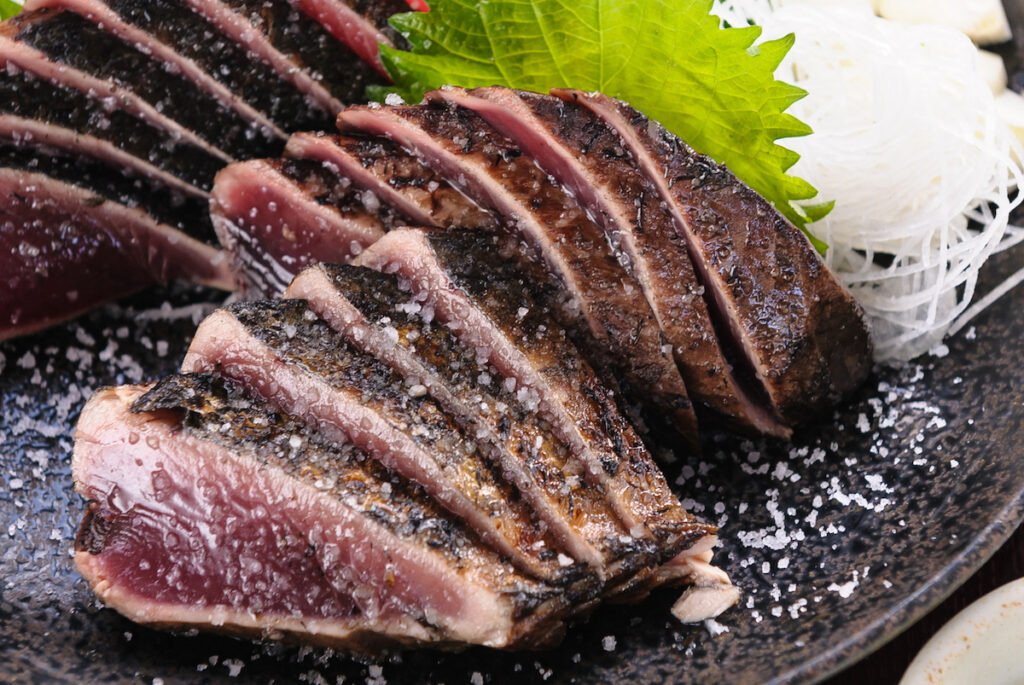5 Japanese Fish to Celebrate Fall
Enjoy Our Seafood Picks To Welcome The Cooler Season
As we transition to autumn weather, why not seek out soups and stews brimming with fall’s bounty? Fatty fishes are among the most popular treats and help keep you full—and healthy—as the season changes.
With its cooler breezes, gray-blue skies and rainy patches, perhaps Japan’s fall weather may not immediately bring to mind seafood. But, in fact, autumn abounds with delicious fish and is known as one of the best seasons to consume the freshest of catches. As the heat of August and early September fades, fish around the archipelago become particularly juicy as they fatten up to withstand the winter. So, some popular fish, like saba (mackerel) and sake (salmon) which are available year-round, are considered to be even more delicious as the leaves start to change.
The fish discussed below were selected for their unique attributes, flavors and seasonality. They are some of the tastiest and symbolic of Japan’s fall time, with perhaps none as representative as sanma (pacific saury), the first fish on our list.
Pacific Saury
 © Photo by iStock: Promo_Link
© Photo by iStock: Promo_LinkSlender and relatively long at about 30 centimeters, the shiny, silver-bodied sanma arrives in droves along the eastern coast of Japan to lay their eggs. In season from September to November, sanma only becomes juicier and fattier as the weather cools off. Also, while sanma caught off the Sanriku Coast are both high in demand and in saturated fat, the ones from southern regions tend to be lower in fat and come with a more delicate taste.
 © Photo by iStock: Hanasaki
© Photo by iStock: HanasakiSanma are delicious when simply salted, grilled and served with a spritz of sudachi (Japanese citrus that resembles lime). You can also pickle them or broil them with soy sauce for great results. Just be aware that they are bone-riddled, so be careful when serving them, especially to children.
Red Seabream & Crimson Seabream
 © Photo by iStock: KPS
© Photo by iStock: KPSWhile a variety of seabreams are eaten all year round in Japan, madai (red sea bream) and chidai (crimson sea bream) are two types that come into season from October to November. Nearly identical in appearance with the exception of chidai’s slightly more reddish scales, they differ when it comes to size and availability. Chidai tops out at about 30-40 centimeters, while madai can reach up to a meter in length. Because madai is fish-farmed far more than caught in the wild, it is the most common variety of sea bream and the likelier one to encounter at your supermarket. In terms of taste and texture, both fish have succulent flesh, offer little in the way of fishiness and are loaded with plenty of umami between the skin and meat.
 © Photo by iStock: bonchan
© Photo by iStock: bonchanThese seabreams are often cooked via shioyaki, which is essentially sprinkling salt and sake on a whole fish (tall and head included) and grilling it. Another popular method is to simmer the fish in soy sauce, which further softens the flesh, making it plump and delicious.
Japanese Sculpin
 © Photo by iStock: JianGang Wang
© Photo by iStock: JianGang WangAlthough kajika (Japanese sculpin) may be a rare find these days, it is nevertheless highly sought after for its unusual appearance and taste. Belonging to the sculpinidae family, kajika, with their gray-brown color and large heads, have the unfortunate honor of being from the same group as the blobfish, a fish widely considered to be one of the ugliest in the world. However, whatever points it may lose in looks, it gains tremendously in taste which is characterized by a meaty texture, sweetness and flavor akin to venison. Rich in iron, calcium and vitamin B2, kajika are great for your taste buds and your health.
 © Photo by iStock: Morita Mika
© Photo by iStock: Morita MikaHokkaido and Kanazawa are both home to local kajika recipes that prepare the fish in hot pots and stews. In Hokkaido, the whole fish is chopped into large chunks and stewed in a miso-based broth, a soothing dish particularly when the weather gets colder. As for Kanazawa cuisine, there’s deep-fried kajika where the fish is eaten in its entirety, including the bones!
Bonito
 © Photo by iStock: Promo_Link
© Photo by iStock: Promo_LinkKatsuo (bonito) has a long history in Japan with archeologists unearthing 5,000-year-old remains in Aomori prefecture. Today, katsuo comes into season twice a year, once during the spring and early summer, and again in the fall when the appropriately named modori-katsuo returns to the waters around Japan. The autumn katsuo, caught between mid-September to early November, is especially fatty and juicy. Plumped up as they prepare for the winter, these returning katsuo are packed with umami just under their thin skin.
 © Photo by iStock: tsuchi
© Photo by iStock: tsuchiBonito are loaded with plenty of protein and essential amino acids to help keep our bodies healthy. As the prefecture with the highest consumption of katsuo in Japan, Kochi affords bonito a special place in their local cuisine. One of the most popular bonito preparations in the region is katsuo tataki, a dish that features raw, meaty slices of katsuo bordered by a thin layer that has been fire-seared. Serve with a squeeze of ponzu and a touch of salt and enjoy this rare yet smoky Kochi soul food.
Sardines
 © Photo by iStock: bonchan
© Photo by iStock: bonchanWhile the silvery-blue iwashi (sardines) may bring to mind canned foods and school lunches, they are also a popular autumn fish with more versatility than many may expect. Iwashi’s popularity is relatively recent. Due to its delicate stomach which often disintegrates at an incredible rate soon after being caught, iwashi were not a fish traditionally served on the vast majority of Japanese dinner tables. Thanks to innovations in refrigeration, however, iwashi can now be found all year round and in every corner of the country. For many, late summer to autumn is considered to be the best time for sardines.
 © Photo by iStock: Promo_Link
© Photo by iStock: Promo_LinkA cheap and healthy oily fish packed with omega-3 fatty acids, sardines can be eaten in a variety of ways. Iwashi tend to have a strong flavor and, as a result, often come prepared with grated ginger or marinated with vinegar. With lots of small bones that are difficult to remove, iwashi are also commonly deep-fried to remove the problematic little nuisances. Cooked with sake and soy sauce, iwashi shoyuyaki is a great compliment to your autumn dinner.
What’s your favorite autumn seafood dish? Did we miss a local favorite in our highlights list above? Let us know in the comments below!
















Leave a Reply